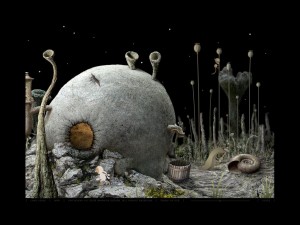Samorost 2
 As you’re no doubt already aware if you’re the sort of person who reads blogs like this one, Wolfire Games organized a second “Humble Indie Bundle” this holiday season, a collection of indie games offered on a pay-what-you-want basis for charity. This has served as a reminder that I still haven’t played everything from the first Humble Indie Bundle, which I purchased just before this year’s chronological rundown. So, let’s start to take care of that.
As you’re no doubt already aware if you’re the sort of person who reads blogs like this one, Wolfire Games organized a second “Humble Indie Bundle” this holiday season, a collection of indie games offered on a pay-what-you-want basis for charity. This has served as a reminder that I still haven’t played everything from the first Humble Indie Bundle, which I purchased just before this year’s chronological rundown. So, let’s start to take care of that.
Samorost 2 is the sequel to the free web-based Flash adventure game Samorost, and has a lot in common with it. Both games are basically click-and-wiggle affairs like Windosill, things where your the results of your actions aren’t very predictable and you just have to poke at things and observe the effects until you figure out how to poke at them in the right order, or with the right timing, or whatever is necessary. The Samorost setting is a bizarre little world, consisting of highly-detailed asteroids that look like they’re made of decaying tree bark and similar materials, populated by a collage of cartoon, photograph, and things in between. Interesting art, good music, lots of things that react to you — although perhaps not enough to really satisfy.
In both games, your goal is to help a little man (gnome?) in a white stocking cap overcome the obstacles on a strange asteroid in order to return peace and tranquility to his home asteroid. And I’d like to emphasize the word “help” there: in no sense do you play the character of the little man. Most often, the objects you click on are completely out of his reach; sometimes he’s not even on the screen until you prepare the way for him. You can sometimes make him move from place to place, but it seems more like a polite suggestion than a command. You could think of this as a kind of naivism in interactivity design, ignoring questions like “What is the player in the game-world?” and “Does this sort of activity make sense?” in favor of simple, gut-level manipulation of things. The one big change that Samorost 2 makes to the interactivity of the original is that now you can sometimes pick things up and click them on other things. (Not that there’s an inventory. It’s more like the pseudo-inventory in Myst, which let you carry one red or blue page at a time.)
The original Samorost was quite short, consisting of a mere six screens worth of random-ish environmental puzzlery. The sequel is quite a bit larger, but it’s still a one-sitting game, unless you miss a hotspot and get stuck. That’s altogether likely to happen, though; I had to consult a walkthrough at one point to unstick myself, and it was of course because of a hotspot I missed. This is the sort of game where you have to wave the cursor around a lot to distinguish clickable details from non-clickable details, and sometimes the clickability of something changes in response to your actions.
 Comments(0)
Comments(0)